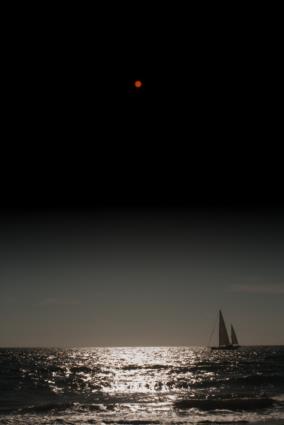
NavList:
A Community Devoted to the Preservation and Practice of Celestial Navigation and Other Methods of Traditional Wayfinding
From: Greg Rudzinski
Date: 2016 Jan 28, 05:41 -0800
Bob,
I use a Canon Rebel 10 mega pixel with a 35mm lens from the deck of a sailboat in weather to take Sun observations up to 35° altitude. Solar film is used to cover the Sun. 1/500 second is fast enough to keep the horizon and Sun limb sharp. The focus needs to be always set at infinite in manual mode (auto focus is no good). Setting the camera clock to UT preserves time for each observation. Precision is about 1' which is plenty good for underway CN. Doing a round of stars underway is difficult due to much slower exposure times.
Your daughters full frame Canon will be able to observe up to 35° altitude with the fixed 50mm prime lens set to manual mode. Precision will be better than 1' with 20+ mega pixels. Star observations may be easier to snap if ISO settings are at or above 64,000.
Lightroom 5 does a good job of image processing and Windows paint does a good job for counting the pixels to convert to an Hs altitude.
Post your raw calibration images when you get them. They should look like the attached example.
Greg Rudzinski
P.S. No need for a gyroscopic mount. Hand holding the camera works from the sailboat cockpit and is actually quicker at taking the observation than by sextant.
From: Bill Lionheart
Date: 2016 Jan 27, 23:31 -0800Thanks to every one for the really helpful info and ideas. My daughter is a profession photographer and is home at the weekend so I thought I might enlist her help as she has one of the top Canon professional 35mm DSLRs (I cant remember which model) which has a full size sensor and a 50mm prime lens. My plan was to try this on a standard tripod at home.
Peter's suggestion of a long and short exposure is an interesting one I had not thought of that. I was assuming I would take several in quick succession on a setting that is a compramise for the moon and the star.
Then the fun starts to do the image processing. I had not thought much tabout the moon's features. I was asuming segmentation and least squares fit of a circle would be a good first stab.
What I was thinking in the long term is that as DSLR sensors improve in resoluution and low light capability at some point it might be possible to make an partially automated CN for use at sea as a fall back when all the satelites crash in to a crowd of space junk and all the GNNS systems fail. I wanted to see how close we are to this now with top of the range DSLRs. Of course luna distance for time correction makes me seem like a seriously crazy "disaster preper" as there are planty of HF time signals. Partly I wanted to have a try at this as I could do it more easily from home and it seems easier that an artificial horizon with a camera as the angle is smaller. It may be that the sensitivity of the sensors is more important than the pixel resolution so shorter exposures can be used on a moving deck. I I was thinking that "software" image staibilization might be possibe rather than a giroscopic mount.







